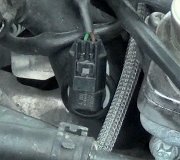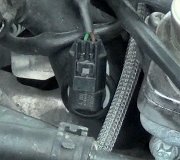P0116 - Engine Coolant Temperature Circuit Range/Performance Problem
You're going about this the wrong way. Diagnostic fault codes never say to replace parts or that they're defective. They only indicate the circuit or system that needs further diagnosis, or the unacceptable operating condition. When a part is referenced in a fault code, it is actually the cause of that code about half of the time. For the other half, you have to rule out wiring and connector problems first. That's what mechanics have to do before they settle on replacing a part.
In this case, temperature sensors have an extremely low failure rate because there is just one component inside them. You are much more likely to find a wire rubbed through or a corroded or stretched connector terminal. When there is an open circuit, as in when the sensor is unplugged, the Engine Computer will see the full 5.0 volts it applied to it, and that triggers the fault code and the computer turns the radiator fan on. Running the fan is a safeguard in case the engine were to run hot. The computer wouldn't know because of the open circuit. In fact, on a lot of cars that is a quick and simple test to see if the radiator fan circuit is working. Unplug the two-wire coolant temperature sensor, (not the single-wire sensor which is for the dash gauge), and the radiator fan will turn on, a fault code will be set, and the Check Engine light will turn on. Once you reconnect the sensor, the Check Engine light will turn off right away or after restarting the engine. The fault code will remain in memory and will usually self-erase after a certain number of engine starts.
You're right about the thermostat. Some manufacturers really appreciate it when you buy more parts than are needed, and to make sure you do that, they package them that way. GM has been famous for that with their all-in-one HEI distributors and their generator assemblies.
I found a photo of the thermostat assembly on the Rock Auto site. There's about two pages of instructions and drawings on how to replace it but I can't copy from that online service manual site. In this case you want to address the problem, which is related to the temperature sensor. There's no need to go after the thermostat. Wait with that until you actually have a thermostat problem.
To find the coolant temperature sensor, normally you just follow the upper radiator hose to the thermostat housing, and it's on or near that. For your car there is a short list of instructions to find it.
Here's the list from Mitchell ProDemand:
Remove the engine cover.
Undo the cap on the expansion tank to release pressure.
Detach the secondary air hose from the turbocharger intake manifold.
Remove the air cleaner casing cover and the bolts on the radiator member.
Detach the turbocharger intake manifold at the mass air flow sensor, and remove it.
Lift up the heat shield and unplug the coolant temperature sensor connector.
Remove the sensor using 83 96 087 sleeve.
Before you go through all this, you might want to have the problem diagnosed by a mechanic. He will connect a scanner so he can view live data and see exactly what the coolant temperature sensor is reporting. He can also wiggle the wires to see if anything changes, and he will ground the sensor to see if the reading changes. Those tests will tell him if the sensor is actually causing the problem.
Image (Click to make bigger)
SPONSORED LINKS
Monday, June 15th, 2015 AT 7:37 PM





